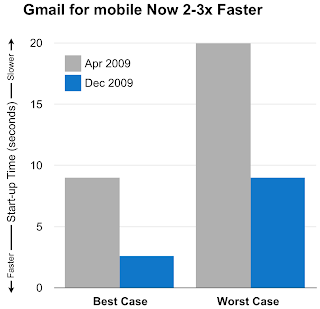A growing number of mobile devices ship with an all-important feature: a modern web browser. And this is significant for two reasons:
- As an engineering team, we can build a single app with HTML and JavaScript, and have it "just work" across many mobile operating systems. The cost savings are substantial, not to mention the time you can re-invest in user-requested features.
- Having a web application also means we can launch products and features as soon as they're ready. And for users, the latest version of the app is always just a URL and a refresh away.
Over the past 8 months we've pushed the limits of HTML5 to launch a steady string of Gmail features, including:
- Full label support
- Swipe to Archive
- Smart Links
- Faster address auto-complete
- Move and Enhanced Refresh
- Outbox
- Auto-expanding compose boxes
- And many more...
As of today, and thanks to numerous optimizations, I'm happy to report that Gmail for mobile loads 2-3x faster than it did in April (see Figure 1). In fact on newer iPhone and Android devices, the app now loads in under 3 seconds. So yes, the mobile web can deliver really responsive applications.

Figure 1: Best and Worst Case Gmail for mobile start-up times, April 2009 vs. December 2009. All figures recorded on an iPhone 3G with EDGE data access.
The Gmail for mobile team isn't done, of course. We've focused primarily on performance over the past few months, but many other features and optimizations are on the way. So keep visiting gmail.com for the latest and greatest version of the app.
Looking ahead, it's also worth noting that as a worldwide mobile team, we'll continue to build native apps where it makes sense. But we're incredibly optimistic about the future of the mobile web -- both for developers and for the users we serve.
No comments:
Post a Comment